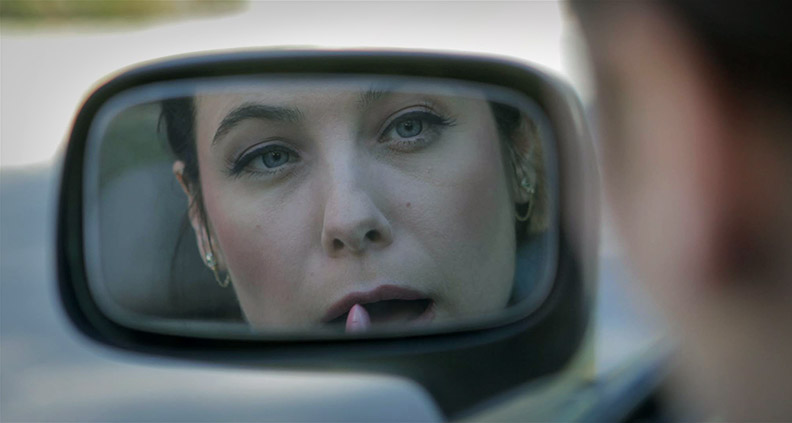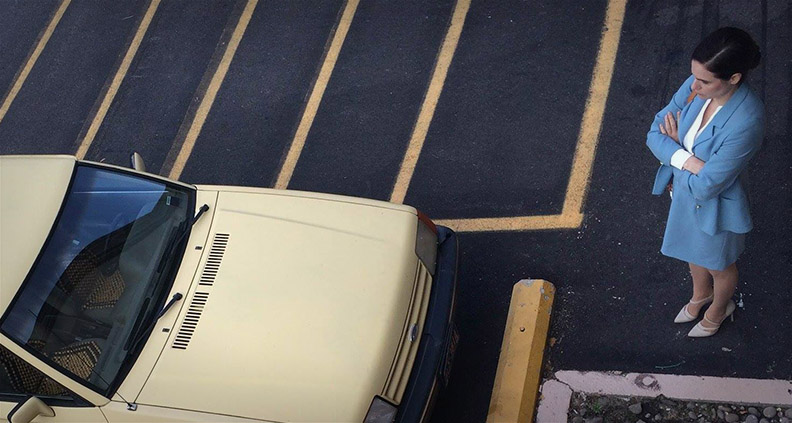How ‘Easy Living’ Put Female Characters First and Got Free Cameras
EDITOR’S NOTE: This interview originally ran in September of 2016. Beginning today, Easy Living is having a theatrical run at Cinema Village in NYC and will be released by Gravitas Ventures on VOD/iTunes/Amazon on Sept 19th.
EASY LIVING
To paraphrase this year’s Democratic Presidential hopeful, it takes a village to make an independent feature. Just ask New York-based filmmakers Laura Wagner and Adam Keleman, whose hybrid comedy-drama-thriller Easy Living (which Kelemen directed and Wagner co-produced) is currently in post-production and looking ahead to a 2017 release. Easy Living was made possible in part by the Film Independent AbelCine Feature Film Grant, which furnished—free of charge—the production’s camera package.
The film—starring Caroline Dhavernas (Wonderfalls, Hannibal) as a troubled traveling saleswoman seeking to reinvent herself through new opportunities in both business and romance—began with Keleman’s desire to create a complicated female protagonist. Cinematographer James Axel West achieved the timeless look and feel of the film by using the Sony F55 camera, which were made available through the grant based on Wagner’s prior Film Independent Spirit Award nomination for the film It Felt Like Love.

The AbelCine Feature Film Grant is a program for Film Independent Fellows, alumni of the LA Film Festival and Film Independent Spirit Award Nominees. Applicants must be the director, producer or cinematographer of a narrative fiction feature that is preparing to shoot in the United States. One qualified filmmaker will be loaned a digital camera package to use for his or her feature film production.
We recently chatted with Wagner and Keleman over email to discuss the inspiration for Easy Living, the challenges they’ve faced in putting it together and how receiving outside support has made it all possible:
Could you please describe Easy Living and what inspired you to make it?
Keleman: Easy Living is about a self-destructive makeup saleswoman trying to put her life together and find connection. It’s also about failing upwards. I wanted to make a film about a complex, rich female character trying to find her place in the world. I wanted to see what a female version of what the Maysles brothers’ Salesman would be like, which was a big inspiration for the film.
What do you hope people take away from the film, either stylistically or thematically?
Keleman: I hope people find the lead character relatable in her pursuit of success, happiness and connection. She’s a bold character, but doesn’t necessarily have the skillset to get what she wants. Hopefully people can find something to like in all her absurdity and wrong choices. Visually, I wanted the film to have a timeless feel and have audiences sink into the minimalist mise en scène through long takes and conversations.
What’s the current status of the project? When do you expect that it will be completed and what are your hopes for it?
Keleman: The film is currently in post-production and will be released in 2017. I hope the film has a wide release because I strongly feel Caroline Dhavernas’s lead performance is magnetic and charming and must be seen.

What was your visual approach to shooting Easy Living? Why did you want to shoot using the Sony F55?
Keleman: I wanted the look and feel of the film to be timeless—to exist in a world similar to ours, but all its own. The palette suggests a late-’80s/early-’90s vibe. I mostly framed actors in two-shot medium and wide set-ups, saving close-ups for more intimate and raw moments. The combination of the Slog3 gamma curve and S-Gamut3.Cine color space featured on the Sony F55 allows for a lot of flexibility and range with color and image, which proves a powerful cinematic tool for indie filmmakers.
What other films or filmmakers do you find the most visually inspiring? Was there any film or filmmaker in particular you were hoping to emulate?
Keleman: In terms of visuals, I’m a big fan of Rainer Werner Fassbinder and the way he uses an entire space and frames actors, and his use of color. Robert Altman is a big cornerstone for me as well in the way he follows actors with slow zooms and pans, allowing moments to occur organically. John Huston’s Fat City and Mike Nichol’s Silkwood were also big stylistic influences on Easy Living.
Do you have any advice for young filmmakers trying to get their features made?
Keleman: The best advice I could give is to shape your story around the resources you have at your disposal, whether it’s locations, people or props. Use what you have access to and be smart and creative in simple and resourceful ways. Try to get your script read by as many smart professionals as you can. You want your script to be in the best place possible before shooting. You should be open to notes but not obliged to them. And raising money is the most difficult part. There are some grants out there, so do the research and apply to everything you can.
Can you describe the support you received from AbelCine and Film Independent?
Wagner: I cannot overstate how important the support from AbelCine and Film Independent was for our production. As we were preparing to shoot in the New York metropolitan area in the fall of 2015, it became apparent that camera packages were extremely scarce because of the amount of filming activity in the area. Being a low-budget indie, we couldn’t afford to throw money at the problem. Our DP, James Axel West, and I literally called every camera house and every individual camera owner we could find in NYC and we were coming up empty. The Artist Development team at Film Independent stepped up and started making calls on our behalf. When AbelCine offered us the grant package, we were overjoyed. Not only did they grant us a camera package but they accommodated our shooting schedule at a very busy time and they provided the highest quality gear available.
What have some of your biggest challenges been during this production?
Wagner: The biggest challenges always have to do with restrictions with time and money. Fortunately, I scheduled the shoot with an extra day in mind, and we only had one day go over 12 hours. Having to cut things from the script that were too expensive to film was hard to take, but you have to figure out creative ways to make things work—hitting similar beats in the story through scaled-down action sequences. Also, you end up taking on one too many jobs. Next time I will definitely hire a 1st AD!
Who was your cinematographer, and how was their approach to solving problems different than your own?
Keleman: My cinematographer is James Axel West. I’ve worked with him before, and we have a great shorthand between us. James understands light so well, coming from a photography background. I love to frame a camera, but James really can find the lighting without a lot of resources. And he knows how to troubleshoot things so quickly; he made it look like dusk outside on a bright sunny morning, which saved us, let me tell you!
Could you describe your relationship to Film Independent prior to embarking on this project?
Wagner: My relationship with Film Independent began when I was nominated for the John Cassavetes Award at the Film Independent Spirit Awards for a film that I produced, It Felt Like Love. Film Independent had awarded that film with a Dolby DCP Grant. After the Spirit Awards, I began to meet occasionally with the Artist Development team at Film Independent and discovered that they offered valuable resources including labs, grants and mentorship to filmmakers like myself. I continue to reach out to them for advice on all of my projects, and I am very grateful for the ongoing support.
To learn more about Easy Living please visit the film’s website. For more information about additional support opportunities for filmmakers, please visit our grants page. Not a Member of Film Independent yet? What are you waiting for? Click here to become one today.